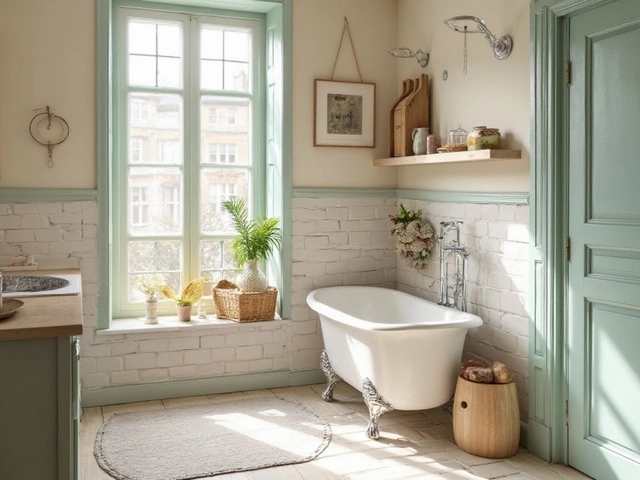Most folks picture renovations starting with a sledgehammer. The truth? The very first step, before you even touch a wall, is planning. Jumping straight into demo without a game plan is like heading out on a road trip with no map, no snacks, and a half-empty gas tank. That's how you end up lost, hungry, and broke.
Why is planning so crucial? Ever seen those home reno shows where people stumble into mold, busted wiring, or a surprise wall nobody expected? That’s what a lack of planning gets you—unexpected headaches and blown budgets. Good planning is boring on paper but saves huge headaches later. Work out exactly what you want, how much you can really spend, and who you’ll need on your team before swinging the hammer.
- Why Planning Trumps Demolition
- Figuring Out What You Really Want
- Setting a Realistic Budget
- Getting the Paperwork Sorted
- Finding the Right Help
- Kickstarting with Confidence
Why Planning Trumps Demolition
Smashing out walls feels like progress, but hold up—starting renovations by planning saves time, cash, and stress. The National Association of Home Builders found that over 30% of renovation projects go over budget just because people underestimate the risks and surprises hiding behind the walls. That’s a headache you can skip.
When it comes to house renovation, think of planning as your safety net. You need to know what’s behind those walls—plumbing, electric lines, maybe some old insulation or water damage. Missing these details can wreck your budget fast. Take it from 2023’s HomeAdvisor report: unplanned issues tacked an average of $3,000 onto renovation costs. A little time on planning up front pays off big in the end.
- Plan out what rooms you actually want to change and how you’ll use them.
- Figure out if you need permits—tearing out a support wall without permission can stop your job and drain your wallet.
- Get some pros to look behind the scenes for any hidden problems before you start swinging tools.
Check out this quick table on common issues discovered when people skip thoughtful planning:
| Missed Item | Average Surprise Cost | Common Consequence |
|---|---|---|
| Mold/Water Damage | $2,700 | Delays, health issues |
| Faulty Wiring | $1,900 | Electrical risk, code violations |
| Structural Problems | $4,000+ | Project shutdown |
If you plan your steps instead of tearing things out at random, you dodge these expensive landmines. Take your time upfront. It might not be exciting, but it’s the smartest way to start a renovation for real results.
Figuring Out What You Really Want
It’s easy to say, “Let’s redo the kitchen!”—but what does that actually mean to you, your family, and your wallet? Before firing up any power tools, get specific about your goals. Do you want more space to cook? Better energy efficiency? Are you hoping to boost home value, or just want your space to work better for your daily life? Getting clear right away avoids costly changes later on. People who skip this step often end up tearing down brand new walls—or blowing their budgets because they chased one Pinterest photo after another.
Start by making a list of real problems with your current setup. Is it a lack of storage? Old, squeaky floors? Plumbing that’s been leaking for years? Be brutally honest about what’s bugging you. Ask family or housemates what drives them nuts too. Sometimes, the little stuff—the door that never closes, the awkward hallway—turns into the smartest renovation move.
Here’s one way to think it through:
- Walk through each room and note down what doesn’t work or feel right.
- Snap photos so you can point out exactly what you want changed when talking to a contractor or designer.
- Make a “must-have” list with non-negotiables (like fixing that unsafe staircase), and a “wish list” of things that would be nice but aren’t required (like heated floors).
If you’re hoping for a serious return on investment, it’s smart to check what projects actually pay off. Recent data from Remodeling Magazine’s 2024 Cost vs. Value Report reveals:
| Project | Average Cost (US) | Average Resale Value | Cost Recouped |
|---|---|---|---|
| Minor Kitchen Remodel | $26,800 | $22,500 | 84% |
| Bathroom Remodel | $24,300 | $16,200 | 67% |
| Entry Door Replacement (Steel) | $2,400 | $1,800 | 75% |
These stats show not every renovation dollar goes back into your pocket right away. It helps to nail down your priorities from the get-go. Ask yourself: Are you more about comfort and function, or looking to sell in a year or two? There’s no right answer, but you should know your motivation.
Bottom line: Take the time now to define what you really want out of your house renovation. You’ll save yourself stress, time, and a whole lot of cash down the road. That’s how smart house renovation projects start—by getting clear before getting dirty.
Setting a Realistic Budget
If you skip the budget part, you might as well toss your wallet into a blender. Before you fall for those slick before-and-after pics, you need to figure out what you can actually afford. Most people think they have a ballpark number in their heads, but renovation costs add up fast, and surprise expenses always pop up.
Experts recommend adding 15-20% to your original estimate for unexpected stuff—like finding outdated wiring or ancient plumbing hiding in the walls. Tight on cash? There’s no shame in scaling back the dream kitchen for now. A honest, tight budget helps you decide what really matters.
Here’s what makes up a typical house renovation budget:
- Material costs (flooring, paint, fixtures, appliances)
- Labor (contractors, plumbers, electricians, painters)
- Permits and inspections
- Unexpected repairs (water damage, pest problems, rot)
- Temporary living or storage costs if you have to move out
Let’s get real with the numbers. Check out this table to see the average price ranges for popular home renovation projects in the U.S. in 2025:
| Project | Low-End | High-End |
|---|---|---|
| Kitchen remodel | $15,000 | $70,000+ |
| Bathroom remodel | $8,000 | $35,000 |
| Roof replacement | $9,000 | $30,000 |
| Full home renovation | $100,000 | $250,000+ |
Don’t forget, prices always swing higher in city areas or if you pick fancy finishes. The best way to pin down your budget is to list every cost you can think of and then cross-check it against your bank account. If you’re using financing, make sure you understand the terms and what your monthly payments will actually look like.
One last thing—always, always get written quotes from your contractors. Verbal promises are useless when the bills start rolling in. Put it in writing and you’ll save yourself a lot of grief.

Getting the Paperwork Sorted
This part might feel like the grown-up with a clipboard at the party, but paperwork is what keeps your house renovation on track and legal. Skipping it is risky business. You could end up facing fines, project delays, or even having to undo all your hard work.
First off, check if you need a permit. In the U.S., most cities require a building permit if you're making structural changes, moving plumbing or electrical lines, or adding square footage. For example, replacing kitchen cabinets? Probably no permit needed. Tearing down a wall or adding a new bathroom? Yes, you’ll almost definitely need one. When in doubt, call your city’s permit office. It’s better to feel a little silly asking questions than to get hit with a stop-work order halfway through the job.
Here's a quick look at what your city or county might ask for:
- Blueprints or detailed renovation plans
- Survey of your property, showing boundaries and existing structures
- Contractor license info (if you’re hiring out work)
- Proof of insurance
If you live in an area controlled by a Homeowner’s Association (HOA), don’t forget them. Some HOAs are strict and want to review your plans or even pick your paint colors. Missing this step can lead to major headaches, like having to rip out that awesome deck you just built.
There are some surprising stats out there: about 12% of home renovations are delayed due to missing or incorrect permits, and over 30% of first-time renovators end up with unplanned fees because of paperwork issues. Just look at the numbers:
| Paperwork Problem | How Often It Happens |
|---|---|
| Project Delayed Due to No Permit | 12% |
| Unexpected Fines/Fees | 31% |
| Redoing Unapproved Work | 8% |
You’ll also want to keep all receipts, contracts, and inspection reports organized. These aren’t just for “just in case” scenarios—insurance companies, future buyers, and even your local tax guy may want to see them. Grab a folder or a cloud drive and keep everything in one place. You’ll thank yourself later.
Finding the Right Help
This is where most people either make their renovation a breeze or a total nightmare. Trying to tackle everything yourself is tempting, but most home renovations need someone with real know-how. In fact, house renovation projects that involve electrical, plumbing, or structural work almost always require licensed pros by law in most states. Good luck navigating that permit office with just YouTube experience.
Don’t just pick the first contractor your neighbor mentions. Ask for proof of insurance and references. It’s easy for anyone to make a sweet website, but it’s the word-of-mouth that matters. The National Association of Home Builders (NAHB) reported in 2024 that 67% of homeowners who were happiest with their reno got several quotes and checked references before signing a contract. It really pays off to do your homework.
Here’s a quick rundown on what you should look for in your renovation team:
- License and insurance: No exceptions.
- Clear contract: Get every detail in writing, down to paint brands and tile types.
- References: At least three recent ones, and actually call them.
- Communication: You want someone who replies fast and explains things simply.
- Fair payment schedule: Never front all the money. Divide payments with clear milestones.
If you feel lost comparing quotes, make a table. It’ll take some legwork, but you won’t regret it:
| Contractor | License | Insured | Quote Amount | References |
|---|---|---|---|---|
| BuildRight Co. | Yes | Yes | $18,000 | 3 called, all positive |
| DreamRenovators | Yes | Yes | $22,000 | 2 out of 3 positive |
| QuickFix Homes | No | No | $14,500 | 1 unreachable, 1 negative |
One last tip: if someone says your job doesn’t need permits and it obviously does, run. Bad contractors cut corners all the time, and you’ll get stuck fixing it later. Taking a little extra time to find the right help makes all the difference in any renovation.
Kickstarting with Confidence
Starting house renovations isn’t just about nerves or excitement—it’s about making smart moves from the get-go. So once your plans and budget are sorted, how do you actually get the ball rolling and dodge all the early mistakes?
The first order of business is to make sure communication lines are wide open. If you’re working with a contractor, set up a kick-off meeting. Bring everyone together—contractors, designers, even the plumber—so questions get answered before work starts. According to a 2023 Houzz survey, 58% of homeowners who skipped initial meetings had delays within the first three weeks of the project.
A quick house renovation checklist for your first week could look like this:
- Confirm your contractor’s start date and timeline (write it down!).
- Double-check permits—don’t let paperwork stall your reno.
- Clear out anything valuable or breakable from the work zones.
- Set up a spot for supplies and tools so you don't lose hours searching.
- Snap photos of everything, especially hidden stuff like wiring or plumbing.
Want some fast numbers? Here’s a look at the three big reasons projects get off to a rocky start according to recent renovation industry surveys:
| Issue | % of Projects Affected |
|---|---|
| Poor Communication | 44% |
| Lack of Clear Schedule | 32% |
| Permit Problems | 21% |
If you remember nothing else, remember this: being organized up front makes everything smoother. Having your team on the same page and all your ducks in a row is what separates a reno that runs on time from one that drags on for months. Even little things—like sharing daily check-ins or having a group chat—make a difference. That’s how you start strong and keep your sanity.





